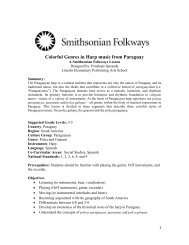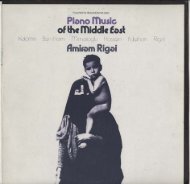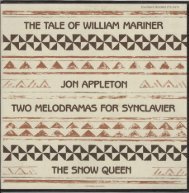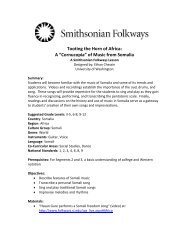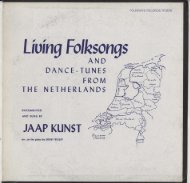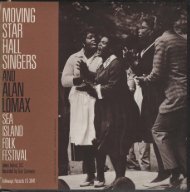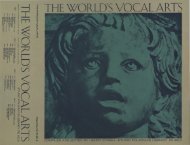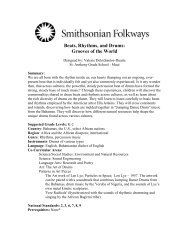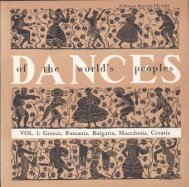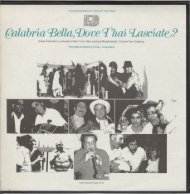You also want an ePaper? Increase the reach of your titles
YUMPU automatically turns print PDFs into web optimized ePapers that Google loves.
The first volume in this collection contains examples<strong>of</strong> five forms <strong>of</strong> maulidi: Maulidi ya Kiswahil~ Maulidiat-Habshi, Maulidi Barazanji, Maulidi Diriji andMaulidi Sharaful Anam or Kukangaya.Maulidi is <strong>the</strong> most popular musical form in I.amu.It is first <strong>of</strong> all a Muslim ritual marking <strong>the</strong> birth <strong>of</strong><strong>the</strong> Prophet Muhammad, but it is also, both to <strong>the</strong>local participant and to <strong>the</strong> outside observer, anexciting performance. It reaches a peak <strong>of</strong> public display'during <strong>the</strong> month-long annual celebration <strong>of</strong> <strong>the</strong> actualbirth <strong>of</strong> <strong>the</strong> Prophet, but it also occurs throughout <strong>the</strong>year in private celebrations in homes or public recitalsin <strong>the</strong> mosques or on <strong>the</strong> streets <strong>of</strong> <strong>the</strong> town. The fivedifferent styles in use in I.amu all consist <strong>of</strong> chantedreadings and hymns in praise <strong>of</strong> <strong>the</strong> Prophet. In spite <strong>of</strong><strong>the</strong> strong musical component in maulidi, people referto it as "readings" ra<strong>the</strong>r than music, <strong>the</strong>reby reflecting<strong>the</strong> orthodox Muslim reluctance to be involved in <strong>the</strong>overindulgence or uncontrolled expression <strong>of</strong>tenVolume IMaulidlSide 1Maulidt ya KtswahUtassociated with musical performance.The forms <strong>of</strong> maulidi contain texts describing eventsin <strong>the</strong> life <strong>of</strong> <strong>the</strong> Prophet and maxims for proper livingderived from <strong>the</strong> Prophet's example. These are chantedby a religiOUS leader in a style similar to <strong>the</strong> chanting<strong>of</strong> <strong>the</strong> sacred Koran. Interspersed with <strong>the</strong>se readingsare <strong>the</strong> hymns in praise <strong>of</strong> <strong>the</strong> Prophet, usually sung byall in attendance. In three <strong>of</strong> <strong>the</strong> styles, <strong>the</strong> matariaccompany <strong>the</strong> hymns, while in two, <strong>the</strong> hymns aresung without instrumental accompaniment, usingbody rhythm to establish <strong>the</strong> basic pulse.The examples on this record demonstrate clearly<strong>the</strong> commonality <strong>of</strong> structure <strong>of</strong> <strong>the</strong> five styles. Thedifferences among <strong>the</strong>m should also be apparent.Different groups and individuals in I.amu have <strong>the</strong>irfavorite styles, which are used at various times andon different occasions, but nearly everyone in I.amuwould heartily agree that maulidi is undoubtedly <strong>the</strong>irmost treasured musical form.Maulidi ya Kiswahil; as it exists today, has developedout <strong>of</strong> older forms which can no longer be clearlydescribed by <strong>the</strong> people <strong>of</strong> I.amu. The readings used inMau/idi ya Kiswahili are <strong>of</strong>ten referred to as Maulidiat Debi, a form published in 1912 in Bombay, India,but no doubt composed much earlier. Knowledgeableinformants ~y that <strong>the</strong> Debi readings have been alteredby <strong>the</strong> addition <strong>of</strong> poems original to I.amu or materialfrom o<strong>the</strong>r forms <strong>of</strong> maulidi. 10 addition, Maulidi yaKiswahili is occasionally referred to as Maulidi ya Rama,<strong>the</strong> "shaking maulidi," referring to <strong>the</strong> movementsmade at <strong>the</strong> climax <strong>of</strong> <strong>the</strong> hymns. Some think Maulidiya Rama was once a distinct form <strong>of</strong> maulidi in itsown right, but most evidence indicates it is an earlierand perhaps derogatory name for what is called Maulidiya Kiswahili today.Maulidi ya Kiswahili is <strong>the</strong> only style <strong>of</strong> maulidi inI.amu in which Kiswahili is used. The language <strong>of</strong> sacredritual is Arabic, so that, even in Maulidi ya Kiswahil~<strong>the</strong> readings and many <strong>of</strong> <strong>the</strong> hymns are in Arabic.Traditionally, new songs or verses were created on <strong>the</strong>spur <strong>of</strong> <strong>the</strong> moment in <strong>the</strong> midst <strong>of</strong> heightened devotion,but this rarely happens today. Old favorites are <strong>the</strong>rule. Maulidi ya Kiswahili readings <strong>of</strong>ten occur in streetswhich have been set <strong>of</strong>f for <strong>the</strong> purpose by placingmats on <strong>the</strong> ground and enclosing <strong>the</strong> central area withropes tied to temporary poles. lights are strung between<strong>the</strong> poles and colored bits <strong>of</strong> cloth or paper are tiedto <strong>the</strong> ropes. At <strong>the</strong> height <strong>of</strong> a reading more than onehundred men and boys participate while o<strong>the</strong>rs ga<strong>the</strong>raround <strong>the</strong> perimeter.The participants sit in two long rows on <strong>the</strong> matsfacing each o<strong>the</strong>r. One row contains <strong>the</strong> readers ando<strong>the</strong>r leading religiOUS figures <strong>of</strong> ramu and <strong>the</strong> threematan players. Exact position in this row is determinedby age or respect for a person's status, especially in <strong>the</strong>religiOUS hierarchy <strong>of</strong> <strong>the</strong> town. The o<strong>the</strong>r row containsyounger men and boys who at certain points in <strong>the</strong>ritual perform stylized dances on <strong>the</strong>ir knees, swayingfrom side to side. The drums accompany <strong>the</strong> hymns8but are silent during <strong>the</strong> readings. Each drum is tunedto a particular tension or pitch and each drummerplays a different rhythmiC pattern. The three drumstoge<strong>the</strong>r create a dynamic and forceful accompanimentto <strong>the</strong> singing.A Maulidi ya Kiswahili reading begins with fatiha,opening prayers. These are followed by <strong>the</strong> openinghymn which is <strong>the</strong> same at every reading. The first eightor nine verses are chanted by a teacher and <strong>the</strong> restare sung by various individuals, with <strong>the</strong> whole groupjoining in <strong>the</strong> chorus. Ano<strong>the</strong>r reading, chanted by one<strong>of</strong> <strong>the</strong> leading teachers present follows <strong>the</strong> hymn.Readings and hymns alternate until <strong>the</strong> maqam, <strong>the</strong>verse which mentions <strong>the</strong> birth <strong>of</strong> <strong>the</strong> Prophet, isreached. At this point everyone rises and a series <strong>of</strong>hymns unique to this part <strong>of</strong> <strong>the</strong> reading is sung. After<strong>the</strong> singing <strong>of</strong> five or six <strong>of</strong> <strong>the</strong>se hymns, everyone sitsdown again, final prayers called dua are said, andrefreshments <strong>of</strong> dates and c<strong>of</strong>fee are served. The wholereading usually takes about two and a half or three hours.The readings <strong>the</strong>mselves are well known to nearlyeveryone involved since <strong>the</strong>y occur at every performance.However, <strong>the</strong> leader can choose to leave out or includeparticular sections on a given night depending on <strong>the</strong>enthusiasm <strong>of</strong> <strong>the</strong> men participating or o<strong>the</strong>r subjectivejudgments. The first two hymns are <strong>the</strong> same for everyreading, but <strong>the</strong> rest are chosen spontaneously byanyone who wishes to do so, merely by reciting <strong>the</strong>chorus <strong>of</strong> <strong>the</strong> hymn as soon as it becomes apparent<strong>the</strong> reader has finished. The timing <strong>of</strong> <strong>the</strong> entrance<strong>of</strong> <strong>the</strong> hymns is remarkable; <strong>the</strong>re is very little pausebetween readings and hymns. Direct competition <strong>of</strong>two hymns beginning at <strong>the</strong> same time is also rare.The hymns consist <strong>of</strong> a chorus which is sung byeveryone, and verses which are introduced spontaneouslyby various individuals. Most <strong>of</strong> <strong>the</strong> versesare familiar to <strong>the</strong> o<strong>the</strong>rs and many join in with <strong>the</strong>original reciter before he finishes his lines. The versesfor a given hymn vary from reading to reading and areinterchangeable from hymn to hymn, so long as <strong>the</strong>y fit




